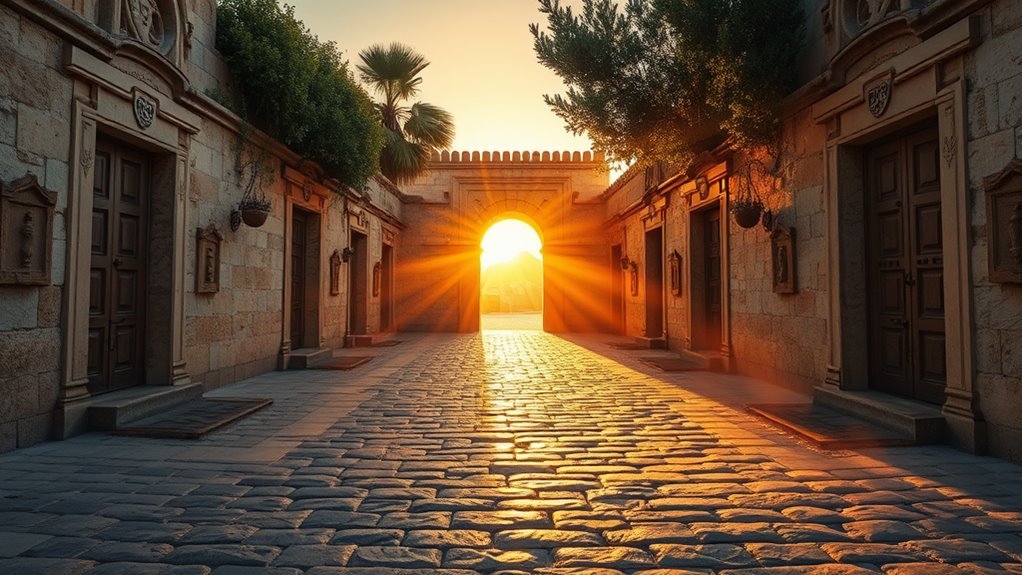13 Spiritual Meanings of the 12 Gates of Jerusalem
As we explore the 13 spiritual meanings of the 12 Gates of Jerusalem, we find that each gate serves as a powerful symbol of transformation and communal resilience. From the Gate of Mercy, where compassion flourishes, to the Gate of Righteousness, which stands for moral integrity, these entrances invite us to reflect on our own journeys. But what do these gates reveal about our paths in today's world? Understanding their significance could challenge our perceptions and inspire deeper connections, leaving us to ponder how they might influence our lives moving forward.
In a Nutshell
- Each gate represents a unique aspect of the spiritual journey, symbolizing transformation, healing, and personal growth within the context of Jerusalem's rich history.
- The Gate of Mercy emphasizes compassion, forgiveness, and the importance of nurturing relationships for collective healing and unity.
- The Gate of Righteousness invites individuals to align their actions with higher moral values, fostering community strength and justice.
- The Gate of Faith signifies milestones in spiritual evolution, encouraging communal support and resilience during life's challenges.
- The Golden Gate symbolizes hope and divine promise, representing the connection between spiritual aspirations and earthly existence.
Historical Significance of the Gates
Throughout history, the gates of Jerusalem have served not just as physical entrances but as symbols of cultural and spiritual significance. Each gate carries a rich historical context that reflects the city's diverse past. As we explore the historical significance of these gates, we find that they weren't merely architectural features; they were essential in shaping the identity and social fabric of Jerusalem.
Consider the New Gate, for example. Built in the late 19th century, it represents a shift towards modernity while still honoring the city's ancient roots. Similarly, the Zion Gate, with its scars from past conflicts, showcases resilience amid adversity. Each gate tells stories of various peoples who've passed through—traders, pilgrims, and conquerors—creating a tapestry of shared experiences.
In understanding gate significance, we realize they embody the hopes, struggles, and aspirations of those who entered and exited. They remind us that Jerusalem is a place of convergence where diverse cultures interact and thrive.
Symbolism of Entry and Exit
The gates of Jerusalem symbolize much more than mere physical barriers; they represent profound moments of entry and exit that resonate deeply within the spiritual and cultural landscape of the city. Each gate invites us to reflect on the entry symbolism and exit significance tied to our own lives.
As we ponder these thresholds, we recognize that they serve as essential markers of transformation and renewal.
- Sacred journeys: Each entrance embodies the initiation of a new spiritual path.
- Cultural exchanges: Exits allow for the sharing of ideas, fostering community and connection.
- Personal growth: Every passage signifies a departure from the old, making way for the new.
In this way, these gates remind us of the cyclical nature of existence. They challenge us to contemplate what we carry with us as we enter and what we release as we exit.
The interplay between entry and exit not only shapes the narrative of Jerusalem but also mirrors our own personal journeys. As we navigate these gates, we find belonging in a shared experience of transformation, echoing the timeless quest for meaning and connection within our lives.
The Gate of Mercy
Mercy flows like a river through the Gate of Mercy, inviting us to explore its rich spiritual significance. As we stand before this sacred entryway, we recognize that it symbolizes the profound nature of compassion and forgiveness. In a world often marred by judgment and division, this gate serves as a reminder of the power found in mercy's embrace.
In examining the Gate of Mercy, we find ourselves called to engage in compassionate acts, both towards ourselves and others. This embrace of mercy encourages us to let go of grievances, creating space for healing and unity. It invites us to reflect on how we can extend kindness in our daily lives, transforming our communities through intentional acts of love.
Moreover, this gate compels us to acknowledge our shared humanity. By stepping through it, we commit to nurturing relationships that are rooted in understanding and empathy. Each time we choose mercy over condemnation, we strengthen the bonds that connect us, enriching our spiritual journey.
Let's embrace the Gate of Mercy, allowing its essence to guide us toward deeper compassion and belonging in our lives.
The Gate of Righteousness
Righteousness stands as a formidable pillar within the spiritual architecture of Jerusalem, inviting us to explore its significance as we approach the Gate of Righteousness. This gate serves as a powerful reminder of our call to embrace righteous living and uphold the principles of divine justice in our lives. It beckons us to reflect on how our choices shape our spiritual journeys and the communities around us.
As we contemplate this sacred entryway, we can visualize:
- The radiant light symbolizing truth and integrity.
- The unwavering strength of a community united in moral purpose.
- The serene landscape where justice and compassion intertwine.
Entering through the Gate of Righteousness encourages us to ponder our actions and their alignment with higher values.
It's here that we find a sacred invitation to embody righteousness, nurturing a relationship with the divine that fosters harmony and peace. This gate reminds us that living righteously isn't just an individual endeavor; it's a collective journey toward creating a just world.
Together, we can walk through this gate, committed to making choices that resonate with the spirit of righteousness and contribute to a more equitable society.
The Gate of Healing
Many seekers of spiritual solace find profound significance in the Gate of Healing, a sacred threshold that invites us to reflect on the transformative power of restoration and renewal. This gate serves as a powerful symbol of the healing energy that permeates our lives, urging us to embrace the potential for deep healing within ourselves and our communities.
As we stand before the Gate of Healing, we're reminded that healing isn't merely a physical process; it embodies a holistic approach that encompasses emotional, mental, and spiritual dimensions. This gate encourages us to seek balance and wholeness, allowing our wounds to become pathways for spiritual renewal.
In facing our challenges, we cultivate resilience, learning to transform pain into strength. Moreover, the Gate of Healing calls us to foster connections with others, recognizing that shared experiences can amplify our healing journeys.
By engaging in communal practices, we harness collective healing energy, nurturing not just ourselves but also those around us. As we explore this gate, we realize that healing is a shared endeavor, inviting us to unite in our quest for wholeness and spiritual rejuvenation.
Together, we can step through this gate, welcoming the profound potential for renewal that awaits.
The Gate of Repentance
As we reflect on the healing journey, we naturally encounter the Gate of Repentance, an essential passage that invites introspection and transformation.
This gate symbolizes a significant moment of spiritual awakening, where we confront our past and embrace the possibility of renewal. Engaging in repentance practices, we not only acknowledge our missteps but also cultivate a deeper understanding of ourselves and our interconnectedness with others.
Through this transformative process, we can visualize:
- The shedding of heavy burdens, freeing our hearts and minds.
- A gentle breeze carrying the whispers of forgiveness, inviting us to let go.
- The soft glow of dawn, illuminating the path to a brighter future.
The Gate of Faith
Stepping through the Gate of Faith, we encounter a profound invitation to explore the depths of our beliefs and the strength they provide. This gate serves as a pivotal entry point in our faith journey, reminding us that faith isn't merely a static concept but a dynamic force that propels us toward spiritual growth.
As we navigate through life's challenges, our faith becomes a beacon, guiding us through uncertainty and instilling a sense of purpose.
In this sacred space, we're encouraged to examine the foundations of our beliefs and how they shape our understanding of ourselves and the world around us. Here, we realize that faith often requires vulnerability; it invites us to embrace doubt and uncertainty as integral parts of our spiritual journey.
By acknowledging these aspects, we cultivate a deeper, more resilient faith.
Moreover, as we gather together at the Gate of Faith, we reinforce our collective understanding and support for one another. Through shared experiences and reflections, we strengthen our bonds, fostering a community that thrives on mutual encouragement and growth.
Consequently, the Gate of Faith stands not only as an individual milestone but as a communal celebration of our spiritual evolution.
The Gate of Praise
At the Gate of Praise, we find an essential passage that invites us to celebrate the transformative power of gratitude and worship. This gate symbolizes our collective journey into deeper spiritual worship, where we engage in praise practices that elevate our hearts and minds. The act of praising not only acknowledges the divine but also unites us in a shared expression of faith.
As we step through this gate, we visualize:
- The warm glow of candlelight illuminating our faces during communal prayers.
- The harmonious sounds of voices lifting high in song, echoing through ancient stone.
- The vibrant colors of banners fluttering in the breeze, reflecting our joy and devotion.
In this sacred space, we recognize that praise is more than mere words; it's an active engagement with the divine that fosters connection, purpose, and belonging.
The Gate of Peace
Having explored the Gate of Praise, we now approach the Gate of Peace, a vital threshold that invites us into a domain of tranquility and harmony.
This gate holds deep significance, symbolizing the essence of peace that transcends mere absence of conflict. As we reflect on its spiritual meaning, we recognize that it represents peaceful changes in our lives, urging us to navigate challenges with grace and understanding.
The Gate of Peace encourages us to cultivate an inner sanctuary where we can embrace both personal and communal serenity.
It's an invitation to foster relationships grounded in empathy and compassion, allowing us to connect more deeply with one another. Here, we're reminded that true peace isn't just a fleeting emotion but a state of being, rooted in our intentions and actions.
The Golden Gate
Nestled within the ancient walls of Jerusalem, the Golden Gate stands as a poignant symbol of hope and divine promise. This gate, often regarded as the divine entrance to the sacred city, embodies a profound connection between the spiritual and earthly domains. Its golden symbolism resonates deeply, inviting us to reflect on our own spiritual journeys.
As we gaze upon the Golden Gate, we can almost sense its stories whispering through time:
- Brilliant sunlight reflecting off golden stones, illuminating the path for the faithful.
- Ancient arches cradling the weight of history, holding dreams and aspirations of generations.
- A serene ambiance enveloping the entrance, inviting contemplation and reverence.
The significance of the Golden Gate transcends its physical structure; it serves as a reminder of the promises made to us and the hope we hold in our hearts.
Each visit to this sacred entryway reinforces our understanding of belonging within the greater tapestry of faith. By embracing the golden symbolism inherent in this gate, we cultivate a deeper connection to our spiritual heritage, reinforcing our faith and unity as we walk together through this divine entrance.
Spiritual Journeys Through the Gates
Each of the 12 gates of Jerusalem serves as a unique portal, inviting us to commence our spiritual journeys with intention and purpose.
As we walk through these gates, we engage in spiritual pathways that lead to profound inner transformations. Each entrance offers us divine guidance, encouraging us to reflect on our personal experiences and connect with the larger tapestry of our faith explorations.
The gates resonate with the echoes of historical pilgrimages, reminding us of the countless souls who've traversed these paths in search of meaning.
Within these sacred spaces, we partake in rituals that foster community connections, strengthening our bonds with one another and enhancing our collective spiritual growth.
Lessons From the Gates
Through the gates of Jerusalem, we uncover invaluable lessons that resonate deeply within our spiritual lives. Each gate offers insights into our journey of personal growth and inner transformation, reminding us that we're part of a rich tapestry of faith exploration and community connection.
- The Gate of Faith encourages us to cultivate resilience building during times of trial.
- The Gate of Mercy invites us to embrace compassion, fostering sacred spaces within our hearts and among each other.
- The Gate of Reflection prompts us to engage with historical reflections, allowing us to learn from the past as we forge our paths forward.
These spiritual lessons guide us as we navigate our individual and collective journeys. They remind us that within the walls of Jerusalem lies not only a city of ancient history but also a source of wisdom that can inspire our daily lives.
The Gates in Modern Spirituality
As we explore the lessons from the gates of Jerusalem, it becomes clear that their significance extends beyond historical and biblical contexts into modern spirituality.
Today, we find ourselves weaving the essence of these gates into our spiritual practices, enriching our urban spirituality with profound meaning. Each gate offers a metaphorical entry point into sacred spaces within ourselves and our communities.
In contemporary interpretations, the gates inspire us to establish modern rituals that foster personal connections and collective experiences. Community gatherings often reflect the spirit of these gates, creating environments where spiritual awakenings can flourish.
We engage in meditation techniques inspired by the gates, allowing us to draw upon their wisdom to navigate our lives with intention and purpose.
Furthermore, the cultural influences surrounding the gates remind us that spirituality isn't a static concept but a dynamic interplay of ideas and experiences.
By integrating the lessons from Jerusalem's gates into our daily lives, we cultivate a deeper sense of belonging, connecting with others who share similar journeys.
Hence, these gates continue to guide us, inviting us to explore the rich tapestry of meaning in our modern spiritual quests.
Frequently Asked Questions
What Rituals Are Associated With Each of the 12 Gates?
When exploring gate symbolism, we find each gate's ritual significance reflects cultural beliefs. By examining these practices, we deepen our understanding of the communities' values and connections, fostering a sense of belonging within shared traditions.
How Do the Gates Relate to Personal Spiritual Growth?
We explore how these gates symbolize personal transformation, guiding our inner journey. Each gate invites us to reflect, learn, and evolve, fostering a sense of belonging and shared growth within ourselves and our communities.
Are There Specific Prayers for Each Gate?
We've explored gate-specific prayers that reflect spiritual significance in our lives. Each prayer invites us to connect deeply, fostering communal bonds and personal growth while enriching our understanding of our shared spiritual journey.
How Can the Gates Influence Daily Life?
The gates symbolize thresholds in our lives, encouraging daily mindfulness. By reflecting on their meanings, we can navigate challenges more thoughtfully, fostering a sense of community and connection as we journey together through life's changes.
What Modern Practices Stem From the Spiritual Meanings of the Gates?
We explore how modern practices, like meditative practices and community gatherings, foster connection and mindfulness. These activities reflect deeper values, encouraging us to engage with each other and our surroundings in meaningful, transformative ways.

Sofia Phillips is a renowned spirituality expert and the visionary behind SoulfulCreature.com. With a compassionate heart and an enlightened mind, Sofia embarks on a quest to guide others through the realms of spirituality. Her approach is deeply rooted in providing a nurturing and positive experience, allowing individuals to explore and grow in their spiritual journey.






